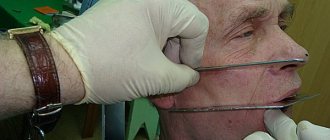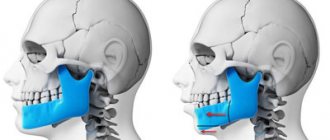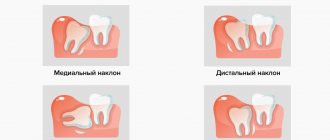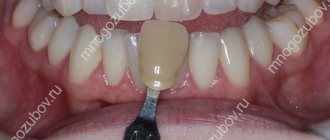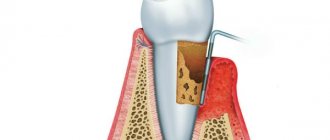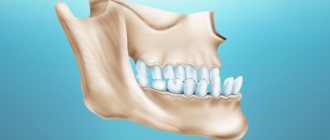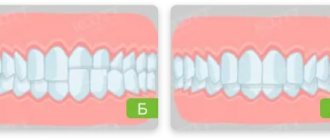Before we begin to explore the question of methods for measuring masticatory efficiency , it is necessary to understand four concepts that are often confused: masticatory force, masticatory efficiency, masticatory pressure and masticatory power. In physiology, chewing force is the force that can be developed by the entire chewing muscles that elevate the lower jaw. It is equal, according to Weber, on average 390-400 kg [the physiological diameter of all three pairs of muscles of the levators of the mandible is 39 cm2 (m. temporalis = 8 cm2, m. masseter = 7.5 cm2, m. pterygoideus medialis = 4 cm2 , and 1 cm2 of the physiological diameter of the muscle can develop a force of 10 kg; therefore, all lifters can develop a force of 390-400 kg).
Dentists, however, are not interested in the absolute or potential force that can be developed by the masticatory muscles, but in the force that the masticatory muscles develop during the performance of the chewing function. The chewing value of the dental system cannot be measured in kilograms. It can be determined in comparative terms by the degree of grinding of food. The degree of grinding to which food is reduced by the dental system while it performs the chewing function is called chewing efficiency. S. E. Gelman uses the term “chewing power” the term “chewing efficiency”. But power in mechanics is the work done per unit of time, it is measured in kilograms. The work of the masticatory apparatus can be measured not in absolute units, but in relative ones - by the degree of grinding of food in the oral cavity as a percentage. Therefore, the result of the work of the masticatory apparatus per unit time in percentage cannot be called chewing power; it would be more correct to call it chewing efficiency. Chewing efficiency is measured as a percentage compared to an intact dentoalveolar system, the chewing efficiency of which is taken as 100%.
In dentistry (at the suggestion of Prof. S. E. Gelman) the term “chewing pressure” is used. Chewing pressure S.E. Gelman calls that part of the chewing force that can be realized only in one particular area of the dental system. Masticatory pressure is measured in kilograms using a gnathodynamometer.
Anatomical features of teeth
Most dentists who work with this topic take the chewing force of the weakest tooth as one. And the pressure of the remaining teeth is determined in comparison with it. Then, when calculating the constant of such pressure, doctors are guided by the following anatomical features of the teeth:
- surface size;
- number of roots;
- presence of bumps;
- distance from the angle of the lower jaw;
- periodontal features
- transverse sections of the neck.
Let's consider chewing efficiency according to Agapov in more detail.
Abutment teeth
The choice of abutment teeth follows a thorough and comprehensive clinical diagnosis. The doctor is obliged to determine the type and type of bite, as well as the relationship of the supporting tooth with neighboring ones and the condition of the periodontium.
In particular, the general condition and level of periodontal strength in a tooth are determined by the doctor based on the mobility of the latter, as well as the balance of the length of its root and the size of the crown, the color of the enamel itself and the presence/absence, and quality of fillings. For a comprehensive assessment of the general condition of the periodontium, the doctor may also prescribe an x-ray examination.
It is important to remember that all teeth with an artificial crown are subjected to radiographic examination; they also have fillings and are altered in color, have changed their position in the gums, and have an increased percentage of abrasion.
Requirements for abutment teeth
There are a number of medical requirements to consider in your assessment. The following criteria are used:
1. Is there a completely healthy periodontium?
2. Does the structure have high, intact crowns?
3. The tooth itself is located in the correct occlusal position and relationship.
Of course, the presented clinical criteria are rarely encountered in the practice of doctors. Plus, future supporting teeth should be located next to the defect itself.
All patients who need the installation of a bridge or clasp prosthesis can be divided into 2 groups
1. Patients who do not have healthy teeth around the correctable defect
– the latter had previously been treated for pulpitis and other diseases, had fillings placed on them, and so on.
2. Patients whose teeth will be used in the future for support meet the previously described requirements.
But in the first case, you can practically use the following as a support for the prosthesis:
1. If there is no pulpitis or caries on the teeth.
2. Teeth diagnosed with chronic periodontitis, the main thing is that all root canals will be filled, have a minimal likelihood of inflammation.
Despite the fact that the teeth described above can be called conditionally healthy, remember that dentures will strain the main, “native” periodontium and therefore certain exacerbations and relapses can easily occur.
Oxman Amendments
Oksman I.M. pointed out the need and importance of taking into account the activity of existing teeth, taking into account their mobility. At the first stage of pathological mobility, chewing efficiency corresponds to 100%. At the second stage - 50%, at the third - its complete absence is stated. The last degree also includes teeth that are affected by periodontitis. Oksman, studying Agapov’s developments, wrote down the antagonist teeth in the form of a fraction. Indicators that indicate a loss of chewing efficiency are recorded in the following order: in the numerator - the maxillary value, in the denominator - the mandibular value. Using this diagram, it is most convenient for a specialist to imagine the state of the masticatory apparatus. Gnathodynamometric values are important in dental prosthetics and orthodontics. They may be influenced by:
- psychological state of the patient;
- measurement reactivity;
- compensatory ability of periodontal receptors and numerous other factors.
Gnatometry is used to track the dynamics of therapeutic procedures and the functionality of implants, measure the pressure between pairs of teeth, and determine the functionality of dentures.
Condition assessment
When biting and chewing food, the elements of the jaw rows are subjected to vertical and transversal (lateral) load. Its magnitude and direction depend on the type of unit and its functionality.
According to N.F. Danilevsky, the load on the incisors is 5-10 kg, on the canines - 15 kg, on the premolars (4 and 5) - 15-20 kg, on the molars (6 and 7) - 20-30 kg.
The value of these loads is not limiting for teeth and periodontium, and amount to approximately 50% of what they are able to withstand without harmful consequences.
Thus, 50% of the permissible load represents a reserve that can be used for prosthetics.
The first stage in selecting support units is to assess their condition and answer the question whether certain units are capable of serving for a long time as a basis for attaching a prosthesis.
In this case, the following is investigated:
- periodontal condition;
- type of bite;
- occlusal interaction of antagonists in the area of the defect;
- presence of mobility;
- crown to root length ratio;
- presence of seals;
- enamel color;
- presence and degree of pathological abrasion;
- arrangement of elements in a row.
The assessment is carried out by examining the oral cavity, probing, percussion, and palpation of the alveolar process. An obligatory step in assessing the condition of the supporting organs is an x-ray examination.
All elements need to be examined, but primarily those that are planned to be used for supports. Particular attention is paid to units with fillings that have changed color, covered with artificial crowns, subject to abrasion, and movable.
Occlusal relationships are clarified on the diagnostic model. To make it, impressions are taken of the jaws. The occlusal pad, which connects the prosthesis to the supporting unit, can disrupt the occlusal relationship of the antagonist pair.
This is interesting: CAD system
There are different ways to correct this deficiency - from preparing the coronal part and making clasp crowns to using another element for support.
Using an x-ray, the presence of atrophy of dentin and periodontal bone tissue is determined. With the adsorption of ¼ of the root length, the reserve capacity of the tooth is reduced by 50%.
If ½ of the root is subject to atrophy, there are no reserve possibilities. When the alveolar bone atrophies by more than half, functional failure occurs.
The ratio of the extra- and intra-alveolar parts, which is an indicator of its stability, is analyzed. The ratio of crown height (L1) and root length (L2) must be within certain limits. L1:L2 should not be greater than one, that is, the length of the root should not be less than the clinical height of the crown.
Units planned for support must be stable. For class 1 and 2 mobility, they must be splinted with adjacent elements.
The shape of clinical crowns must be anatomical. This is especially important for clasp fastening. A cone-shaped low crown, an incorrect ratio of the height of the coronal part and the length of the root (see above), and an exposed neck are contraindications (albeit relative) for using the tooth as an abutment.
Requirements
To make the right decision about the use of specific units as supports, it is important to determine whether they meet the basic requirements:
- Sustainability. To form a stable system, moving elements are locked with adjacent ones.
- Absence of inflammatory foci near the apex . Units with periapical lesions can be used exclusively after canal filling.
- Pronounced anatomical shape. If clamp fixation is intended, elements with a low coronal part in the form of a cone are not suitable.
However, this disadvantage is a relative limitation. After special preparatory measures, such elements can be used in the fastening system. - Parallelism of supports to each other . Sometimes minor violations of this indicator are quite acceptable. But, if we are talking about creating a system of holding supports, strict parallelism is mandatory.
- Optimal relationship between the supporting element and the antagonist .
With a close relationship, even the thinnest occlusal overlay can improve the bite. In such cases, the specialist, as an alternative solution, must choose another unit for support or prepare the problematic element using an inlay and an artificial crown. The use of microprostheses with cervical protrusions is also acceptable.
Remarkable! When planning a fixation system for a denture, the specialist must create a strong and reliable attachment for optimal chewing functionality, as well as provide such a load that the denture would have little impact on the supporting elements, soft tissues and mucosa.
Average values
The chewing efficiency values according to Agapov are shown on the device in kilograms. Average figures vary between 15-36 for front teeth and 45-78 kg for molars. They are important for optimizing prosthetic processes, since they determine the sensitivity of the periodontium to load and help establish the design of a particular prosthesis.
The average values of chewing pressure have been established, which are taken as the basis for observations and the correspondence of the periodontal force load: in women on the incisors - 20-32 kg; in women on molars – 40-62 kg; in men on the incisors – 25-45 kg; in men on molars – 50-75 kg.
How to calculate chewing efficiency according to Agapov is of interest to many.
Pressure on teeth in kilograms
According to the works of N. I. Agapov, there are tables with the distribution of chewing force for each tooth, however, it should be borne in mind that they are all approximate. The endurance of periodontal tissues in general (936 kg in women and 1408 kg in men) is almost never realized, since the greatest contraction power of the masticatory apparatus is 390 kg. Gnatometry is very rarely used in modern dentistry due to the following disadvantages:
- only vertical pressure is determined, but horizontal force is not taken into account;
- the result may not be absolutely accurate;
- rapid spring deformation;
- the result is influenced by the psychosomatic state of the patient, which can change during the day.
Gnathodynamometry
The measurement of chewing force dates back to the 17th century. In 1679, Borelli wrote about the following method for measuring chewing force. He placed a rope on the lower molar, tying its ends, and hung weights from it, thus overcoming the resistance of the masticatory muscles. The weight of the weights pulling the lower jaw down was 180-200 kg. This method of measuring chewing force is very imperfect, since it did not take into account that not only the chewing muscles, but also the cervical muscles took part in holding the load. Black, M. S. Tissenbaum proposed a gnathodynamometer to measure chewing pressure (Fig. 47). This device usually resembles a mouth dilator: it is equipped with two cheeks that are moved apart by a spring. The spring moves the arrow along a scale with divisions depending on the force of closure of the dentition; the arrow indicates more or less chewing pressure. Recently, an electronic gnathodynamometer has been developed (Fig. 48).
Gnathodynamometry has the disadvantage that it measures only vertical pressure, and not horizontal pressure, with the help of which a person crushes and grinds food. In addition, the device does not give accurate measurement results, since the spring quickly deteriorates. Some proponents of gnathodynamometry have established, through numerous measurements, the average chewing pressure figures for the teeth of the upper and lower jaw (Table 4).
However, these numbers, just like others obtained by gnatometry, cannot be used as typical indicators, since the amount of chewing pressure expressed in kilograms depends on the psychosomatic state of the patient during the test, and this state varies from person to person and even among the same individuals at different times. In addition, gnathodynamometry has other disadvantages. Consequently, the given values are not constant, but variable, which explains the sharp discrepancy in the results of measuring chewing pressure according to different authors.
Load calculation
During prosthetics, the natural loads on the periodontium change. The chewing load, which was previously taken by the missing elements, is taken over by the supporting units. To prevent periodontal overload, it is necessary to be able to calculate their permissible load.
A special technique has been developed for calculating the loads on regular and abutment teeth.
One of the main calculated parameters is called “chewing efficiency”. This is the ability to take a load without harmful consequences.
This is interesting: Dental cement for crowns: using the substance at home, pros and cons
It is expressed in individual coefficients assigned to each tooth.
When calculating loads, the assumption is made that the efficiency of the entire jaw apparatus remains 100%. The starting point for assessing the load-bearing capacity of each unit is the chewing efficiency of the weakest of them - the small incisor (“two”). It is 1% or just 1.
The coefficient of all other teeth is determined in relation to the coefficient of the small incisor and is several times higher than the latter. For example, the efficiency of the first painter is 6 units. This means that the load that it can withstand without harmful consequences is 6 times greater than the permissible load for a small incisor.
Two methods for assigning coefficients are used - N.I. Agapov and I.M. Oksman.
Agapov coefficients
This measurement method is carried out using a special apparatus - a gnathodynamometer. It is equipped with specialized sensors that are located in the measuring head of the replaceable part of the device. The sensor interacts with a microammeter and has a special brass plate.
Algorithm of actions during the measurement process:
- the patient is located in a chair in a comfortable position;
- the doctor inserts a removable measuring head into the oral cavity between the movable and upper jaw;
- the patient squeezes the inserted device with his teeth with all his strength until pain appears;
- the scale of the device displays the chewing load indicator;
- the received data is recorded.
The device displays values in kilograms. The maximum allowable figure for the front units is 36 kg. For indigenous people it can reach 78 kg.
In his works, Agapov created calculation tables that helped distribute the chewing load on each element of the jaw row. In general, the technique is based on calculating the functional strength of each bone organ of the oral cavity as a percentage of the entire jaw system.
Let's consider Agapov's table, in which the coefficients are distributed between each unit.
| Teeth | 1 | 2 | 3 | 4 | 5 | 6 | 7 | 8 | Total |
| Chewing coefficient in % | 2 | 1 | 3 | 4 | 4 | 6 | 6 | — | 25 |
Important! Agapov considers it most effective to accept the chewing significance of the entire system as 100% and to calculate the pressure of each unit as a percentage.
The total value must be obtained by summing the chewing coefficients of the remaining units. Calculation of efficiency must be done by the number of paired units, because elements that have lost their antagonists practically do not function.
Oxman coefficients
This method is based on calculating chewing value using an anatomical and physiological algorithm.
Action steps:
- assessment of each tooth, including eights;
- taking into account the area of chewing and cutting surfaces;
- counting mounds, root systems;
- study of the characteristics of periodontal structures;
- assessment of the functional value of the unit.
A thorough study of mobility will help to obtain the following indicators:
- the first degree is the norm;
- second degree of precarity – reduction of the percentage value by half;
- mobility of the third degree - bone organs are considered absent.
Remarkable! The functional capabilities of each tooth are taken into account not only by its anatomical and topographical data, but by its ability to function optimally.
Oxman coefficient table.
| Units | 1 | 2 | 3 | 4 | 5 | 6 | 7 | 8 | Total |
| Upper jaw | 2 | 1 | 2 | 3 | 3 | 6 | 5 | 3 | 25 |
| Movable jaw | 1 | 1 | 2 | 3 | 3 | 6 | 5 | 4 | 25 |
From clinical observations it follows that the difference in the total endurance coefficient of periodontal tissues of supports and missing teeth should not be more than one element.
You can unload periodontal supports in the following ways:
- use additional supporting bone organs in prosthetics;
- make the chewing surface area smaller (by modeling the prosthetic structure);
- refuse to create bumps on the chewing surface;
- create points of contact between the supports and natural teeth, which will allow for optimal distribution of the horizontal component of the loads.
Masticationography according to I.S. Rubinov
I. S. Rubinov, studying the mechanism of reflexes carried out in the oral cavity, developed a graphic method for taking into account the motor function of the masticatory apparatus. Using special devices (mastikatsiograph), all possible movements of the lower jaw are recorded on a kymograph or oscilloscope tape. From the curves one can judge the nature of the chewing movements of the lower jaw. This method is called by the author masticationography (recording of chewing).
The essence of this method is that with the help of a masticometer, consisting of a rubber balloon and a plastic case, all possible movements of the lower jaw are recorded on a rotating kymograph tape by air transmission through the Marey capsule (Fig. 49).
Graphically, the normal intake of one piece of food until the moment of swallowing is characterized by five phases (Fig. 50). On a masticogram, each phase has its own characteristic graphic picture.
Phase I - resting phase - before introducing food into the mouth. In this case, the lower jaw is motionless, the muscles are in minimal tone, the lower dentition is separated from the upper at a distance of 2-3 mm. On the masticogram, this phase is indicated as a straight line (I) at the beginning of the chewing period at the level between the base and the top of the wavy curve.
Phase II is the phase of introducing food into the mouth. This phase corresponds to the moment of introducing a piece of food into the mouth. Graphically, this phase corresponds to the first ascending leg of the curve (II), which begins immediately from the rest line. The scope of this knee is maximally expressed, and its steepness indicates the speed of introducing food into the mouth.
Phase III is the phase of the beginning of the chewing function, or the indicative phase. This phase begins from the top of the ascending knee and corresponds to the process of adaptation to chewing a piece of food and its further mechanical processing. Depending on the physical and mechanical properties of food, changes occur in the rhythm and scope of the curve of a given phase. During the first crushing of a whole piece of food in one movement (method), the curve of this phase has a pronounced flat top (plateau), turning into a gently descending bend to the level of the resting line. During the initial crushing and compression of an individual piece of food in several stages (movements), by finding the best place and position for compression and crushing, corresponding changes occur in the nature of the curve. Against the background of the flat plateau (peak), there is a series of short additional wave-like rises located above the level of the rest line.
Phase IV is the phase of the main chewing function. Graphically, this phase is characterized by the correct alternation of periodic chewing waves. The nature and duration of these waves in a normal masticatory apparatus depend on the consistency and size of the piece of food. When chewing soft food, frequent, uniform rises and falls of chewing waves are observed. When chewing solid food, at the beginning of the phase of the main chewing function, more rare descents of the chewing wave are noted. The harder the food is and provides more resistance, slowing down the moment of raising the lower jaw, the more flat the descending knee. Then, successively, the rise and fall of chewing waves become more frequent. The intervals between individual waves (0) correspond to pauses when the lower jaw stops during closure. The size of these intervals indicates the length of time the dentition remains in the closure stage. Closure can occur with contact of chewing surfaces and without contact. This can be judged by the level of location of the line of intervals or “closing loops,” as they will be called below. The location of the “closing loops” above the level of the resting line indicates a lack of contact between the dentition. If the “closing loops” are located below the rest line, this means that the chewing surfaces of the teeth are in contact or close to contact.
The width of the loop formed by the descending limb of one masticatory wave and the descending limb of the other indicates the speed of transition from closing to opening of the dentition. An acute loop angle indicates that the food has undergone short-term compression. An increase in this angle indicates a longer duration of food compression between the teeth. The straight platform of this loop indicates a corresponding stop of the lower jaw in the process of crushing food. A “closing loop” with a wave-like rise in the middle (0) indicates the rubbing of food during sliding movements of the lower jaw. The graphical picture of the curve of the main phase of the chewing function described above gives an idea of how the sequential compression and crushing of food and its grinding occur.
Phase V is the phase of formation of a lump followed by swallowing it. Graphically, this phase is marked by a wave-like curve with a slight decrease in the height of the swings of these waves. The act of forming a bolus and preparing it for swallowing depends on the properties of the food. With soft food, the lump is formed in one go; with solid, crumbly food, it is formed and swallowed in several stages. According to these movements, curves are recorded on a rotating kymograph tape. After swallowing a bolus of food, a new state of rest of the masticatory apparatus is established. Graphically, this state of rest is represented as a horizontal line (1). It serves as the first phase of the next chewing period.
The ratio of the duration of individual phases of the chewing period and the nature of the sections of the curve vary depending on the size of the food bolus, the consistency of food, appetite, age, individual characteristics, and the state of the neuroreflex connections of the masticatory apparatus and the central nervous system. When using the mastication method, the appropriate recording apparatus should be used correctly, and the analysis of curves should be based on accurate knowledge of the physiological foundations of the masticatory apparatus.
Did you like the article? Share with friends
0
Similar articles
Next articles
- Methods for studying the general condition of the body of an orthopedic patient
- Contents and formulation of the diagnosis of an orthopedic patient
- Classification of materials used in orthopedic dentistry
- Requirements for basic materials used in orthopedic dentistry
- Imprint. Model. Spoons for taking impressions. Method of obtaining impressions
Previous articles
- Anthropometric examination of the jaws and dental arches
- X-ray methods for examining an orthopedic patient
- Instrumental and hardware methods for examining an orthopedic patient
- Questioning and examination of an orthopedic patient
- Tracheostomy
Chewing coefficients - decoding
N.I. Agapov took the efficiency of the dental apparatus as 100%, and the small incisor as the constant of endurance and chewing ability of the periodontium, comparing all the teeth with it. Thus, in his table, each tooth has a constant coefficient.
Subsequently, N.I. Agapov made an amendment to this table, recommending that when calculating the chewing efficiency of the dentition, the presence of antagonist teeth should be taken into account.
In determining chewing efficiency according to Agapov, the value of each tooth is constant and does not depend in any way on the condition of the periodontium. For example, the role of the canine in chewing is always determined by the same coefficient, which does not depend on whether it has pathological mobility. This is considered a serious flaw in the system being disassembled. However, there have been attempts to create new systems in which the strength of the periodontium to chewing pressure depended on the degree of its damage. In this case, an assessment is given to each tooth, including the wisdom tooth. This takes into account the surface area, the number of roots and cusps, the characteristics of the periodontium and its place in the dental arch. The lateral incisors, being functionally weak, were taken as one. Central incisors and canines - two units, first molars - six, premolars - three. As a result of such calculations, a new table was compiled.
This is interesting: Symptoms and treatment of dental cysts under the crown using folk remedies
Physiological test according to I.S. Rubinov
I. S. Rubinov developed the following physiological tests to take into account the effectiveness of the act of chewing. The subject is asked to chew one nut kernel weighing 800 mg (the average weight of a nut) on a certain side until the swallowing reflex appears. The patient spits out the chewed mass into a cup, rinses his mouth with water and spits it into the same cup. Subsequently, the mass is processed according to Gelman, i.e., washed, dried and sifted through a sieve with 2.4 mm round holes, and the resulting residue is weighed. For the same purpose, he used crackers (500 mg) and a piece of soft bread weighing 1 g, equal to the volume of the nut kernel, and the chewing time before swallowing these pieces was taken into account. These studies have shown that as the condition of the masticatory apparatus deteriorates, the time of chewing before swallowing lengthens and the size of swallowed particles increases. For example, in adults with a full-fledged chewing apparatus, the duration of chewing one nut kernel before swallowing is on average 14 seconds, and the remainder in the sieve is 0. In the absence of 2-3 teeth on one side, the chewing time before swallowing one nut kernel is 22 seconds, and the remainder in a sieve is 150 mg. For unsatisfactory complete dentures, the chewing time of one nut kernel before swallowing is 50 seconds, and the residue in the sieve is 350 mg. The difference in indicators is most clearly revealed when chewing a nut, weaker when chewing a cracker, and even weaker when chewing soft bread.
I. S. Rubinov points out that a test with chewing one kernel of a nut before swallowing, compared to 5 g consisting of several kernels, is closer to normal natural food irritation and makes it possible to take into account the effectiveness of chewing in different areas of the dentition and individual groups of articulating teeth. The single core test can also be successfully used to evaluate the percentage of masticatory effect. The percentage is calculated as in the sample according to S.E. Gelman, i.e. the weight of the nut kernel is related to the residue in the sieve as 100: x.
If the patient is unable to chew the nut kernel, then a test with a cracker can be used. The criterion for judging the effectiveness of chewing is the duration of chewing before swallowing (the period of chewing a cracker before swallowing is on average 8 seconds). When chewing a cracker, a complex set of motor and secretory reflexes is obtained. These reflexes operate from the moment a piece of food enters the mouth. In this case, the motor reflex is associated with crushing the cracker, and the secretory reflex is associated with the secretion of saliva, which moistens and lubricates the rough particles of the cracker before swallowing.
By helping to break down food substances, chewing movements increase the impact of saliva and promote faster bolus formation and swallowing. Observations by I. S. Rubinov showed that with the appearance of dry mouth after taking atropine, the time of chewing before swallowing lengthens, and the size of the swallowed pieces increases.
Efficiency calculation
The above tabular data for Agapov and Oksman make it possible to calculate the chewing efficiency of any combination of support units and the possibility of replacing missing ones with them.
For example, the 1st molar according to Agapov’s method has the same efficiency (6) as 4 incisors (2 + 1 + 1 + 2 = 6).
To ensure a complete replacement of missing units with supports, their total chewing efficiency should not be less than the total efficiency of lost teeth by more than 2 units.
Static systems in the form of tables
To calculate the periodontal endurance and the strength of each tooth during the chewing process, certain tables have been proposed, which are called static systems for determining chewing efficiency. In these tables, the role of each tooth in the chewing process is determined by a constant value, which is expressed as a percentage that determines the decoding of the result.
When compiling such tables, the importance of each tooth is determined by the indicator of the cutting and chewing surface, the size of the surface, the number of roots, as well as the distance at which they are located from the angle of the jaw. Several tables were proposed, which were developed according to a single principle (Wustrow, Duchang, Mamlok, etc.). In domestic practice, the static system for calculating chewing efficiency according to Agapov has become widespread.
Features of installing a bridge structure
The main feature of competent and successful installation of a bridge is the number of teeth that can be used in the fastening system as support.
That is, in addition to the above requirements for the condition and parameters of the teeth, the doctor must take into account how many functional organs are required to properly chew certain foods.
For example, to bite, the patient uses 2-3 units on the upper and movable jaw. This means that the endurance of the internal tissues of these elements varies on average within 30 kg, and the total of two jaws is about 60 kg, which is an ideal indicator for processing hard food.
Based on this, optimal chewing function for a bridge installed on teeth 2.3 and 2.6 or 2.3 and 2.7 will not have a traumatic effect.
Recently, doctors have been inclined to believe that it is better to fix bridge structures on elements of a functionally oriented group that are connected by a single function (2 canines on one jaw, a large-small molar).
It may be optimal to install the structure on the canines and lateral teeth. Structures with such supports and excellent periodontal condition have a longer service life if the supports are properly stable.
When there is a need for prosthetic replacement of a defect in the jaw row in the frontal zone, specialists choose support on the canines. This fixation will compensate for the loss of all four incisors.
In the case of periodontal pathologies, lengthening of the coronal part, poor condition of the alveoli and severe instability, they resort to increasing the number of denture supports by introducing neighboring elements into the system.
Such actions will transform the entire structure into a splint that will restrain the pressure generated during the process of chewing food and tightly closing the jaws.
Clasp devices
To correctly place the structure on the clasps, it is important to determine the fixing line. Experts call it an imaginary axis passing through the supporting elements.
The entire orthopedic structure can be rotated around the created axis. The direction of the clasp axis is always carried out according to the doctor’s decision.
The most unfavorable location for this line is a one-sided direction, in which the prosthesis can tip over and overload the supports. This arrangement of clasps is acceptable in the case when there are preserved elements in the defect area.
The best conditions for installing a partial removable denture are a bilateral arrangement of clasps. Also in the process, the specialist takes into account the diagonal direction of the line of clasps.
Optimal fastening on the movable jaw is ensured when the clasp axis is characterized by a transverse direction.
Remember! The doctor cannot always determine the direction of the clasp line. When calculating the final indicators for installing a prosthesis, data on the topography of defects and information about the state of the internal tissues of living remaining teeth are taken into account.
Determination methods
Voltage measurement according to Agapov is carried out using an electronic gnathodynamometer by Perzashkevich and Rubinov. It includes specialized sensors that are built into the measuring head of a special removable attachment.
The sensor, which is connected to the microammeter, contains a brass plate. A man sits in a chair. It is very important that he is comfortable and psychologically comfortable. The specialist inserts a nozzle into the mouth between the jaws and the patient squeezes it with his teeth until pain occurs. Thus, the chewing pressure is displayed on the device scale at this moment. The sensor values are recorded. Gnathodynamic parameters can depend on many factors:
- person's gender;
- individual characteristics;
- existing diseases (periodontal disease, periodontitis and others);
- partial loss of teeth;
- age.
Reviews
Often it is the condition of the supporting teeth that stops the use of a prosthesis. Failure of a support and, as a result, replacement of prosthetics is a fairly common case.
If you have encountered a similar situation, tell us how it manifested itself and how it ended. You can do this by leaving a review at the bottom of the page.
Sources:
- https://FB.ru/article/425413/jevatelnaya-effektivnost-po-agapovu-metodyi-opredeleniya-printsipyi-rascheta-rasshifrovka-rezultatov
- https://zen.yandex.ru/media/id/5a91834cfd96b107992f8de2/5c05f509817f78040071456c
- https://zubovv.ru/protezirovanie/semnyie-p/pravila-vyibora-opornyih.html
- https://www.vash-dentist.ru/protezirovanie/semnyie-p/algoritm-vyibora-opornyih-zubov.html
